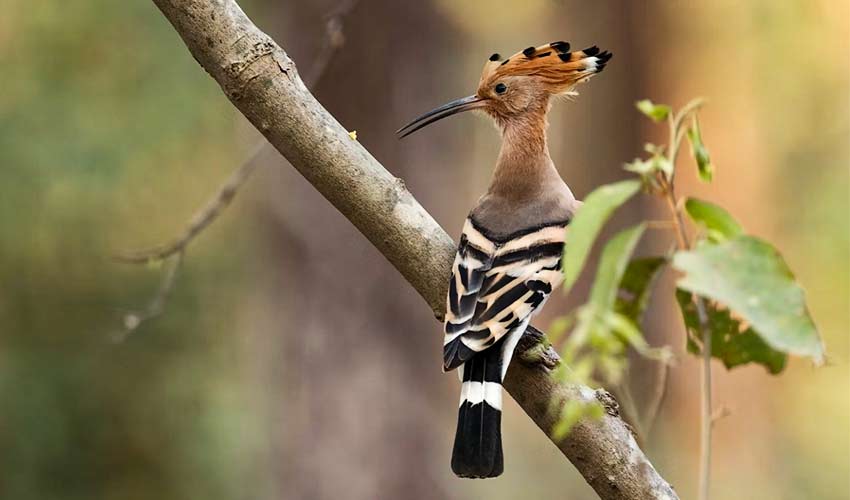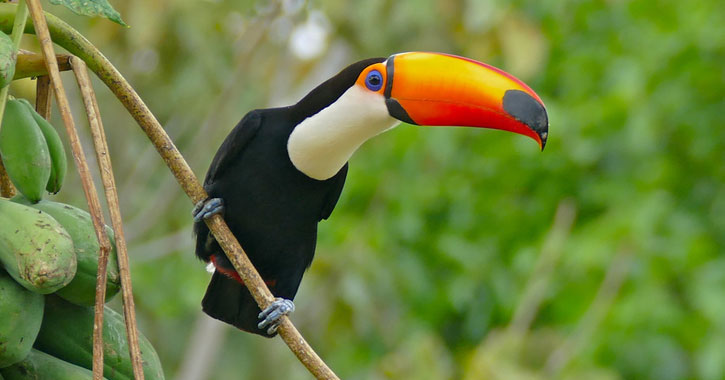Just take a look at these 15 fascinating small birds with long beaks!
Yes, there are many gorgeously-beaked birds in the world that can wow even non-birders. From the different species of pelicans to spoonbills, you can find other more dramatically beaked birds.
This post focuses on smaller birds with pronounced beaks.
Here are my favorites…
15 Fascinating Small Birds with Long Beaks
The beaks of birds grow bigger as they age.
Note that the beak length posted below is for the average size of a full-grown adult bird.
1. Black Skimmer (Rynchops niger)

- Length of beak: 3 to 4 inches
- Where are they found: The Black Skimmer has 3 different species distributed all over the world, including South America, tropical Africa, South Asia, and the coasts of North America.
This long-winged bird looks slightly different, depending on the region they live in.
North America’s Black skimmers have dark tails with white outer feathers, while Argentina’s Black skimmers have brown tails.
Regardless of habitat though, Black skimmers have a knife-like-shaped beak with a lower mandible protruding against the beak’s upper half.
Because Black skimmers are seabirds, they use their beaks to hunt fish and other water creatures by grazing the lower half of their beaks through the surface of the water.
2. Keel-Billed Toucan (Ramphastos sulfuratus)

- Length of beak: 6 to 8 inches
- Where are they found: These gorgeous birds live in tropical, subtropical, and lowland rainforests. You can find Keel-Billed Toucans in southern Mexico, Venezuela, and Colombia.
Keel-billed Toucans are wonderfully colorful birds.
They’re a member of the Toucan family (which are all as striking as this one), but the Keel-billed Toucan is probably one of the smallest by size.
It grows only up to 20 inches average in height with about 6 pounds on average in weight.
The bill of this toucan isn’t just long, it also has wow-factor thanks to its vibrant colors of yellow, orange, red, and green, popping out like a painting.
They also have a pretty cool sound that reminds me of a cricket chirping. Take a listen and see what you think.
Keel-Billed Toucans are omnivores, feeding primarily on berries, fruits, small insects, frogs, lizards, and eggs.
3. Canyon Wren (Catherpes mexicanus)

- Length of beak: 2 to 3 inches
- Where are they found: Canyon Wrens live in rocky canyons of western North America and places like the Grand Canyon.
These brown birds have long tails and bills with contrasting white chests, spotted bodies, and striped tails.
Canyon wrens use their long beaks to find insects with precision in between the crevices of rocks, cliffs, and other hard-to-reach areas.
As their name suggests, their habitats are dry and rocky canyons because canyon wrens can fully survive without water sources.
They get their water from the insects they eat.
4. New Zealand Kiwi (Apteryx)

- Length of beak: 3 to 5 inches
- Where are they found: These wingless birds are found only in New Zealand. You’ll have better chances of finding one at the Zealandia Karori Sanctuary in Wellington, North Island.
New Zealand kiwis are nocturnal, which means they are rarely seen during the day. They can survive up to 25 to 50 years.
The unusually-long beaks of kiwis provide them with a keen sense of smell (it can detect a few parts per million scents).
They also make an impressively loud call from such a small bird.
It’s useful because kiwis use their beaks to sense prey moving underground, and often use it alongside their sharp claws and strong legs as weapons.
5. American Avocet (Recurvirostra americana)

- Length of beak: 3 to 5 inches
- Where are they found: These birds used to be all over the country until they went extinct on the East Coast. You can now find them in Montana, Idaho, Washington, Utah, North and South Dakota, Nebraska, Colorado, New Mexico, Oklahoma, and Texas, but might migrate during winter to Florida and California.
American avocets are wetland birds that spend most of their time foraging in shallow water or on mud flats.
These long, stilts-like-legged birds also have matching thin long (and upturned) beaks that they use for rummaging for small crustaceans in the mud or sand.
6. Collared aracari (Pteroglossus torquatus)

- Length of beak: 4 inches
- Where are they found: They’re found in southern Mexico, Panama, Ecuador, Colombia, Venezuela and Costa Rica.
Also known as the ringed aracari, banded aracari or spot-chested aracari, the Collared aracari is a toucan species with predominantly black feathers with yellow underbellies and hints of red and orange spots.
The most distinct feature of these birds (from the toucan family) is the majestic beaks.
They’re also often seen in small flocks (just like the photo above) with up to 15 Collared Aracaris hanging out at a time.
7. Common snipe (Gallinago gallinago)

- Length of beak: 2 to 3 inches
- Where are they found: Common snipes are found mostly in Europe (usually in the UK or Ireland), but they also spend their winters in central Africa or southern Asia.
Common snipes are brown small shorebirds or “waders” that camouflage perfectly to the mud they are often found in.
They’re small with thin grey legs and straight but super-long bills/beaks, which Common snipes use to catch insects, snails, worms, and other small crustaceans when hunting for food.
8. Hoopoe (Upupidae)

- Length of beak: 2 to 3 inches
- Where are they found: Africa, Asia, and Europe
Hoopoes are small- to medium-sized colorful birds (about 10 to 13 inches) famous for their “crown” of feathers, black and white gorgeous wings, beady round eyes, and short grey feet.
In addition to their colorful displays, they also have a pretty cool song as well.
Take a listen.
These Hoopoes also have long, slightly curved beaks, which they use for pulling out insects from holes in the ground.
9. Red Crossbill (Loxia curvirostra)

- Length of beak: 1 to 2 inches
- Where are they found: in forests of North America and Eurasia
Red Crossbills don’t have the longest beaks on this list, but if you look closely, they have uniquely shaped bills that make them look more dramatic.
The tips of the upper and lower bills of a Red Crossbill cross over each other.
Yes, they don’t meet, but this unique feature enables these orange and brown birds to bite between cones (which they love) and find berries, aphids, and seeds from inside.
10. Rhinoceros Hornbill (Buceros rhinoceros)

- Length of beak: 4 to 5 inches
- Where are they found: Tropical forests of Southeast Asia (more specifically in Malaysia, and the islands of Sumatra, Java and Borneo)
If you see a Rhinoceros Hornbill in nature, this bird could definitely stop you in your tracks.
As one of the bigger birds on this list, Rhinoceros Hornbill can definitely intimidate. And with their unique bill and “horn,” they’re also easy to identify.
The beaks of Rhinoceros Hornbills are hollow and look like a helmet with a golden yellow horn and curved ivory beaks.
Like many long-beaked birds on this list, these hornbills’ bills are used for building their nest, harvesting food, and feeding their chicks.
Here’s an interesting thing about their beaks is that they’re made of keratin (like human fingernails) and that they serve as a “chamber” that amplifies the Rhinoceros Hornbill calls.
11. Sword-billed Hummingbird (Ensifera ensifera)

- Length of beak: 3 to 5 inches
- Where are they found: Argentina, Bolivia, Colombia, Ecuador, Peru and Venezuela
Sword-billed Hummingbirds are one of the largest birds in the hummingbird family.
They were named as such because of their exceptionally-long beaks that resemble a sword. Not counting their tails, the beaks are usually longer than the birds’ bodies.
The elongated beaks are just as long as the Sword-billed Hummingbirds’ tongues.
Not only do these help them feed on flowers easily, but females also push down regurgitated food down directly into the chicks’ stomachs.
Another dramatic thing about these hummingbirds is their glittery green and blue plumage.
In females, the spots are darker than in males.
If you’re interested in other hummingbirds, check out my post about the 12 melodious song birds of PA.
12. Southern Yellow-Billed Hornbill (Tockus leucomelas)

- Length of beak: 3 inches in females, 4 inches in males
- Where are they found: Southern Africa (mostly within the Kalahari Desert)
If you’ve watched the original Lion King movie, this bird became globally famous because of the character Zazu, which was inspired by the Yellow-Billed Hornbill.
Yellow-Billed Hornbills have black and white plumage with long predominantly-black tails and banana-shaped yellow bills made more dramatic thanks to their reddish cheeks.
Like other hornbills, the beaks of these birds have a casque that amplifies their voices and makes their calls extra loud.
13. Eurasian Curlew (Numenius arquata)

- Length of beak: 8 inches long
- Where are they found: They live year-round in the UK and Ireland, but winter over Africa, south Asia, and southern Europe.
Eurasian curlews are one of the largest shorebirds or “waders” in the family of Scolopacidae, mainly because their beaks alone are already around 10 inches.
Those beaks are pretty useful for Eurasian curlews since they wander around swampy wetlands, marsh, and lakeshores, then use their long bills to find insects that like to burrow.
Eurasian curlews are often found in large flocks, especially when roosting or migrating.
14. Red-billed Scythebill (Campylorhamphus trochilirostris)

- Length of beak: 4 to 5 inches
- Where are they found: Argentina, Bolivia, Brazil, Colombia, Ecuador, Panama, Paraguay, Peru, and Venezuela.
Red-billed Scythebills are woodcreepers found in dense forest habitats.
These birds have orange-tinged brown plumage and dark rounded bead eyes.
The beak or bill of the Red-billed Scythebill is long, red, and downcurved.
These birds use their bills to pluck their food from tree trunks, branches, and other harder-to-reach areas in the forest.
15. Toco Toucan (Ramphastos toco)

- Length of beak: 8 inches
- Where are they found: South America
Compared to its close-related Keel-Billed Toucan above, the Toco Toucan is the more popular toucan species (thanks to being depicted in many cartoons and movies).
The Toco Toucan’s beaks may be huge, but they’re all for show. Those beaks are pretty fragile (they’re made of keratin) and are just for intimidating predators but not used as weapons.
Interestingly, their bills are responsible for regulating the body heat of these toucans.
What are Your Favorite Small Birds with Long Beaks?
Many of these small birds with long beaks are on my bucket list of birds to see.
I dream of seeing the Collared aracaris, New Zealand kiwis, and Keel-billed Toucans in person at least once in my life.
How about you? Did any of these birds stand out to you? Have you seen similar birds with exceptionally-long beaks in person?
